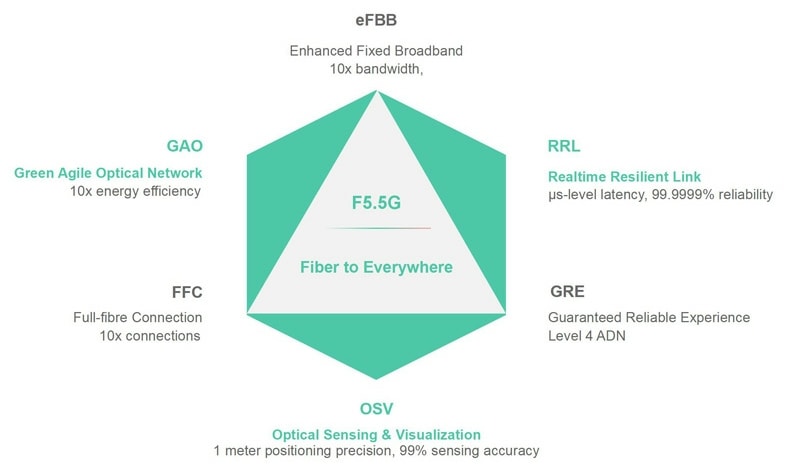New Solutions
F5.5G Unlocks Fiber's Potential and Brings 10Gbps Everywhere
As F5G evolves to F5.5G, innovation in home and enterprise applications and optical sensing will unleash the potential of optical fiber.


By Richard Jin, President, Optical Business Product Line, Huawei

The fixed network industry is rapidly moving from F5G to F5.5G, driven by the twin engines of new network technology developments and growing application demand. The true value of optical fiber will only be able to further shine through this process as technological innovation continues in areas like home and enterprise applications and optical fiber sensing.
Prosperous F5G
Over the past two decades, fixed networks have evolved from meeting just basic connectivity needs to allowing users to enjoy 4K ultra-HD video experiences. F5G standards have also taken shape as fixed network technology evolved to meet booming demand in the digital era. In 2020, the European Telecommunications Standards Institute (ETSI) officially launched F5G and its industry vision of "Fiber to Everywhere". They also defined three technical characteristics of F5G: enhanced fixed broadband (eFBB), full-fiber connection (FFC), and guaranteed reliable experience (GRE). This marked the beginning of the rapid development of fixed broadband networks worldwide.

Then, over the past three years, gigabit fiber broadband rapidly went mainstream as more and more online video and video call services emerged. The number of connected homes with 1 Gbit/s or higher speeds now exceeds 100 million worldwide and is expected to exceed 200 million by the end of 2023. The world's leading information service providers are also already starting to deploy Fiber-to-the-Room (FTTR) solutions to bring high-speed, low-latency, and low-jitter fiber connectivity to every corner of the home. This will meet consumers' expectations for a high-quality Wi-Fi connectivity experience. 2022 alone saw 1 million new FTTR users.
F5G's high bandwidth, low latency, stable transmission, and anti-interference features are making it possible for many industries to go intelligent and digital, facilitating the implementation and success of many new application scenarios. F5G has made its way into more than 10 industries, including transportation, energy, education, and healthcare, covering more than 40 application scenarios. More than 20,000 companies worldwide have developed all-optical Fiber-to-the-Office (FTTO) campuses and all-optical industrial Fiber-to-the-Machine (FTTM) networks, driving industry digital transformation forward.
Digitalization stimulates industry transformation
Given the global progress of informatization and digitalization, we are due for a new wave of transformation. Society is rapidly going networked, digital, and intelligent. The global Internet has continued to expand and transform from meeting consumer demand to addressing industrial requirements, and the availability of data, communications, and computing power has grown exponentially. The needs of consumers, businesses, and other organizations for digital services are also increasing at unprecedented rates.
Network infrastructure is the foundation for digital transformation as well as the foundation of the future world that we will all live in. So what requirements does the future intelligent world have for networks?
We have been pursuing a better video experience, steadily moving from standard definition and high definition to 4K and 8K, as well as real-time, interactive, and immersive experiences delivered by XR and glasses-free 3D video. Metaverse and AR/VR applications are set to change consumer habits and raise higher requirements for communications networks. Excellent broadband quality and low-latency connectivity are required to deliver superior experiences. For example, light-field, glasses-free 3D display requires about 1 Gbit/s of bandwidth and a network latency of less than 5 ms for intensive interactions. Optical reconstruction-based glasses-free 3D display has even higher requirements, requiring about 10 Gbit/s of bandwidth and a latency between 1 and 5 ms. Home networks with 1 to 10 Gbit/s bandwidth and 1 to 5 ms latency are basic requirements for satisfying glasses-free 3D experiences.
Mainstream network applications are also extending from consumer applications to vertical and industrial applications. Industrial applications are often characterized by low latency, deterministic communications, and accurate positioning, while high security and reliability are prerequisites for most vertical applications.
Let's look at power grid as an example. As renewable energy accounts for an increasing percentage of all power generated, different services must be strictly isolated, while scheduling frequency using a supervisory control and data acquisition (SCADA) system must be 10 times higher to ensure stable power supply. This in turn requires a network availability of 99.9999%, meaning an annual outage time shorter than 30 seconds.
Network technology development and application demand growth are driving each other forward. F5G evolution and enhancement will be critical if we hope to meet the requirements of different service scenarios. Multiple industry players have begun discussing the next-generation evolution of fixed networks, and ETSI already released their F5G Advanced and Beyond white paper in September 2022 and initiated F5G Advanced standardization.
F5.5G facilitates ubiquitous 10Gbps optical connections
In April 2022, Huawei proposed the concept of F5.5G to enhance the three existing features of F5G (eFBB, FFC, and GRE) and extend three new features: green agile optical network (GAO), real-time resilient link (RRL), and optical sensing & visualization (OSV).

F5.5G will bring four major changes to the industry. First, it will help us transition from gigabit speeds to ubiquitous 10G speeds. Second, we will change from carrier-grade connectivity to real-time and reliable industrial-grade connectivity, with microsecond-level latency and 99.9999% availability, enabling digital transformation of industries. Third, electric solutions will be replaced with an energy-efficient optical network architecture that is ten times more efficient, enabling green and sustainable development. Fourth, we will transition from optical communications to optical sensing, facilitating integrated optical fiber communications and sensing and digital operation capabilities.
Huawei is also continuing to look into forward-looking technology research and product solution innovation for F5.5G to help operators improve user experience and expand business boundaries.
FTTH to FTTR: The boom in digital home services that we have seen in recent years and the increasing amount of consumer upgrade in home broadband services is setting higher bars for user experience in terms of coverage, rate, roaming, latency, and the number of concurrent connections. More than 100 carriers around the world have deployed FTTR services, tackling the previous obstacles that prevented 100 Mbit/s room access, despite gigabit home access being already common. FTTR unlocks new growth for carriers around the world as it has increased average revenue per user (ARPU) by 30% and reduced Wi-Fi complaints by 60%.
Next-generation FTTR based on the C-WAN architecture further improves the Wi-Fi experience by boosting the effectiveness of collaboration between optical and Wi-Fi solutions through centralized management and control. With it, home users can enjoy over 1 Gbit/s rates and imperceptible roaming handover in less than 20 ms, all while concurrently connecting more than a hundred smart home devices. FTTR helps carriers transform from bandwidth-based operations to experience-based operations, while providing carriers with an optimal approach to smart home services.
10G PON to 50G PON: Many carriers are also making efforts to upgrade their FTTH broadband networks to 10G PON so that more users can enjoy a gigabit ultra-broadband experience. Some leading information service providers have started to verify next-generation high-speed PON technologies. ITU-T officially published the first version of their 50G PON standard in September 2021 as the standard for the next generation of PON technology following 10G PON. This laid the foundation for broadband's evolution from the gigabit era to the 10G era. During commercialization, 50G PON will coexist with GPON and 10PON while also facilitating smooth evolution. It will be crucial for 50G PON to be compatible with existing optical distribution networks (ODNs) to protect carriers' existing investments. With new, innovative device structures and techniques, Huawei's 50G PON optical modules can support 40 km coverage while maintaining compatibility between GPON, 10G PON, and 50G PON on a single port. This will help carriers smoothly upgrade their live networks to 50G PON without network reconstruction and quickly develop the ability to offer ubiquitous 10Gbps experience.
E2E all-optical networks: With the rapid growth of traffic generated by individuals, homes, and enterprises, agile service provisioning and network automation requirements are also increasing. This makes the establishment of E2E all-optical networks and the deployment of OTN/WDM at sites extremely important. OTN/WDM equipment has already been deployed at 85% of aggregation sites and 41% of CO sites worldwide, and is expected to eventually be deployed at all sites to support ubiquitous 10G connectivity. The need for wide-scale deployment at CO sites makes reducing network deployment costs and improving O&M efficiency a top priority for carriers. Huawei's metro Alps-WDM solution uses all-optical switching, an innovative pooling architecture, metro coherent modules, and optical label technologies to realize efficient wavelength sharing and network-wide automation. This improves network energy efficiency, reduces CAPEX during network deployment by 30%, and reduces OPEX by 90%. The WDM pooling solution enables carriers to build a simplified architecture, superior experience, and future-oriented target networks.
Facilitating enterprise digital transformation: FTTR and 50G PON were first designed to optimize home networks and improve bandwidth. However, their technical architectures are also well suited for enterprise campus networks. For small- and medium-sized enterprises (SMEs), Huawei's enterprise FTTR solution enables carriers to extend their Internet private line services to within enterprises by offering Wi-Fi networking services. In addition, 50G PON, alongside Wi-Fi 7/8, will be able to handle rapid growth in enterprise campus service traffic, as office, IT, and OT services eventually converge, and as 90% of enterprise services go cloud-based and 80% of devices are connected. This creates an urgent need to increase the access bandwidth for enterprise campuses.
In manufacturing and industrial interconnection scenarios, E2E OSU technologies, including OSU over PON, enable bandwidth-adjustable hard pipe connections, and high-density timeslot technology can reduce transmission latency to microseconds. These technologies can enable enterprises to build industrial optical networks that are reliable, secure, and constantly evolving while also delivering low latency. Industrial requirements will need these features for ultra-reliability, precision control, and ultra-long-distance coverage. Such networks can also be widely used in scenarios like factories, electric power, transportation, subways, mining, ports, and highways to facilitate industrial digital transformation.
The development of F5.5G fixed network technology will unleash the full potential of optical fibers and lead the industry to stride from 1Gbps everywhere to 10Gbps everywhere. However, collaboration across the entire industry is needed to define the evolution direction of F5G, enrich F5.5G's application scenarios, and enable a prosperous fixed-network industry that can serve as a foundation for the coming intelligent world.
- Tags:
- 5.5G





